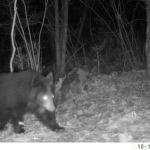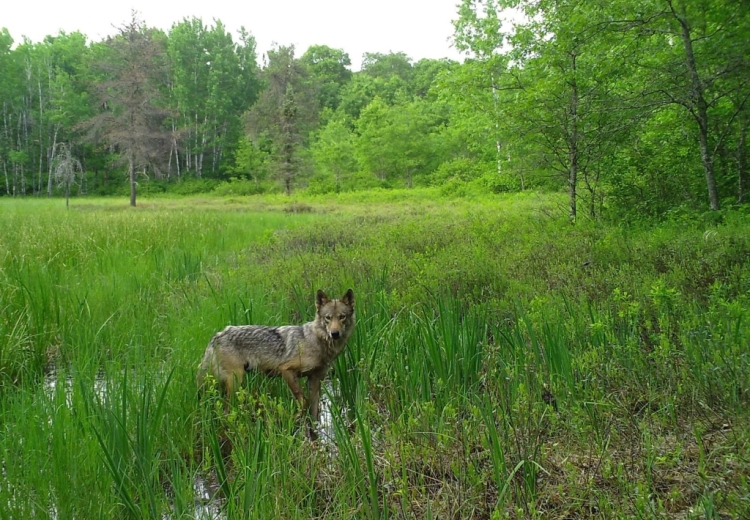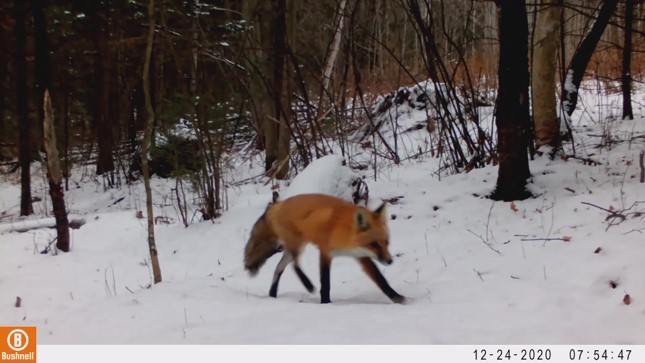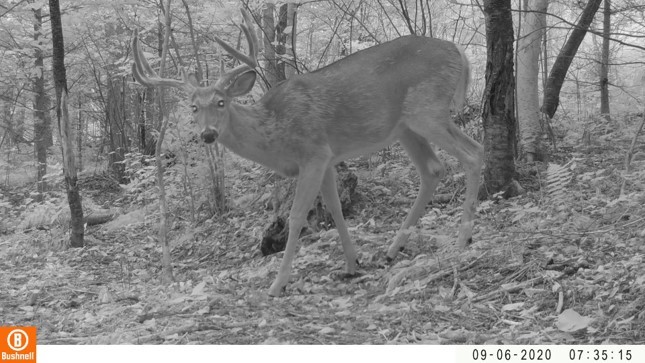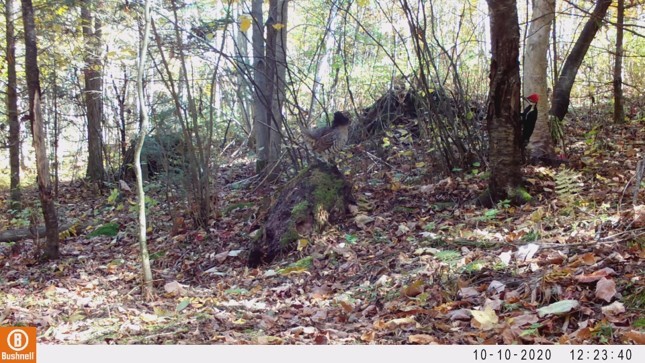Snapshot Wisconsin March 2022
Collaboration is a recurring element in the Snapshot Wisconsin program. Snapshot has worked with NASA and UW-Madison for most of the program’s life. Snapshot collaborates with thousands of volunteers to host trail cameras, and Snapshot teams up with Zooniverse daily to consensus classify many of those generated photos. At our core, collaboration is at the heart of what we do.
In this edition of the Snapshot Wisconsin Newsletter, the team highlights two of Snapshot’s lesser-known collaborations. These partnerships combined Snapshot data with data from other citizen science projects and from private citizens across the country and world. Both collaborations show us how many other people around the globe also care deeply about our natural resources.
The Snapshot team hopes you enjoy reading about these unique collaborations and ways that our volunteers’ efforts are reaching beyond our program.
A National Collaboration Releases Their First Publication!
Snapshot Wisconsin data has been contributing to a similar citizen-science program on a nationwide scale. Read on to find how Wisconsin data was used and learn more about this nationwide program!
From Langlade County, Wisconsin to Zurich, Switzerland
A Snapshot volunteer took on the challenge of monitoring a special trail camera, contributing to an international art project. The project features wildlife from 14 countries around the world and Wisconsin wildlife gets to play a part!
A National Collaboration Releases Their First Publication!
For the last three years, Snapshot Wisconsin has been contributing to a similar citizen science program called Snapshot USA, and Snapshot USA recently reached an important milestone worth celebrating. They released their first publication! Congratulations, Snapshot USA!
In honor of Snapshot USA reaching this milestone, the Snapshot Wisconsin team wanted to highlight this fellow citizen science project and share with our volunteers a lesser-known way that Snapshot Wisconsin data is being used.
What Is Snapshot USA?
Snapshot USA is a national effort to bring together trail camera data from across the country and learn about what drives the distribution of mammal species within the United States. Snapshot USA takes a similar approach to Snapshot Wisconsin, having people classify trail camera photos to generate usable data for science. The main differences are that Snapshot USA is a nationwide effort and is focused entirely on mammals.
Snapshot USA was organized in 2019 by scientists from the North Carolina Museum of Natural Sciences and the Smithsonian Conservation Biology Institute. They asked fellow researchers, citizen science programs (including Snapshot Wisconsin) and private citizens to upload and classify their trail camera photos. Much to everyone’s excitement, over 150 people and programs participated in the effort.
Better yet, people contributed photos from 110 locations across all 50 states, proving that there are people all over this country who value efforts like Snapshot USA and Snapshot Wisconsin.
Snapshot Wisconsin’s Contributions
For our part, the Snapshot Wisconsin program was thrilled to support a fellow citizen science project. We submitted data from 2019 and 2020, and we are working on submitting data from this last year as well. It is important to us to support other programs like Snapshot USA and build up science together.
Every year, Snapshot Wisconsin has contributed data from around 10 of our trail cameras in the Clam Lake elk camera grid. Snapshot USA required at least ten cameras clustered within a 5km area, so only a few areas of our camera grid like the elk camera grids met the requirement.
Despite limitations in which cameras we could include, the Snapshot Wisconsin team is glad that we were able to contribute to this effort at all. Jennifer Stenglein, one of Snapshot Wisconsin’s lead scientists, said, “Snapshot Wisconsin is not set up to have areas with clustered cameras. We made a special exception for the elk grid because the data are used to monitor the growing elk herds across the state. Fortunately, the elk grid matched the minimum requirements to participate.”
Stenglein also mentioned how important it was to her personally that Snapshot Wisconsin contributed to this nationwide effort. “As a scientist, having open data is huge. There is so much trail camera data out there, but it’s [isolated] to specific programs or people. Snapshot USA created a place for trail camera data to come together and be available. That allows scientists to ask questions we couldn’t before, like how climate change is impacting species at a national level.” Stenglein is excited to see what other researchers do with the compiled data.
How Snapshot USA Operates
In addition to sampling populations from across a wider scale than Snapshot Wisconsin, Snapshot USA samples from all major habitats and development zones found within the United States. When a new collaborator joins the program, they select the combination of setting (Urban, Suburban, Rural, Wild, Other) and habitat (Forest, Grassland, Desert, Alpine, Beach, Anthropogenic, Other) that matches their camera site.
Our volunteers may notice that some of these site combinations differ from what Snapshot Wisconsin uses. For example, urban deployment does not fit Snapshot Wisconsin’s criteria for setting up a camera. Stenglein thought that the addition of urban areas adds an interesting element to the dataset, but it shows a fundamental difference in what Snapshot Wisconsin and Snapshot USA are trying to capture.
Next, collaborators upload their photos from a specified time window. In 2019, Snapshot USA collected photos from the 14-week period from August to November. Once uploaded, collaborators could start classifying photos, similarly to how our camera hosts do it.
One important difference is that Snapshot USA puts all their photos through a second round of classification - this time by an expert. Expert review happens within Snapshot Wisconsin as well, but only for the species we’ve learned are classified with lower accuracy. Our accuracy analyses have shown that volunteers do a great job of accurately classifying most species, especially the most common species, so Snapshot Wisconsin only expertly classifies the photos of the hard-to-classify species and rare species. Besides, Snapshot Wisconsin would not be able to expertly classify its 60+ million photos. However, this extra step is possible for a program like Snapshot USA.
“Limiting the time window for data collection is really common in trail camera studies,” said Stenglein. “I don’t know if there is any perfect time window for Snapshot USA to choose, since you will always miss something. However, it does make sense for them to select a window of time. It would be too challenging to collect a whole year’s worth of data, let alone have an expert review.”
Once both rounds of classifications are done, the data are assembled into a package and prepped for release in the form of a new publication. This type of publication is called a “data paper” because its main purpose is to release a new dataset for others to work with.
“It’s a cool, new trend in science for data papers to come out,” said Stenglein. “I’ve seen more effort being put towards proper archiving of data. Researchers can use these datasets to test their own hypotheses and come up with new and exciting insights into wildlife distributions in the USA. I think this is where research needs to be, so it’s encouraging to see this trend.”
2019 Data Is Released
In April 2021, Snapshot USA officially published their 2019 dataset. The paper was published in the scientific journal Ecology and had around 100 different authors.
In total, the dataset included photos from 1,509 cameras across 110 locations, and all 50 states and the District of Columbia contributed data. The dataset had 166,036 observations (photos) and found 83 unique mammal species. Seventeen bird species were also detected, which impressed Stenglein, but the project wasn’t looking for birds, only mammals.
“All together, that’s an impressive number of species detected,” said Stenglein. “Trail cameras aren’t set up to see all species equally. Birds, for example, often spend most of their time above the line of sight of cameras, so capturing 17 species of birds is pretty cool.”
Snapshot Wisconsin’s contributions included sightings of just over 20 of the 83 mammal species found by Snapshot USA. Given the small area that the photos came from, seeing 20 species is a healthy number. If we were able to use more of the grid, that number would have been much higher.
The paper reported that the three most detected species nationwide were white-tailed deer, squirrels and raccoons, in that order. Snapshot Wisconsin’s own data visualization tool, the Data Dashboard, also shows a similar trend, with white-tailed deer and squirrels being the top two species detected in Wisconsin. Racoons weren’t third, but they are high on the list.
Coyotes were the most widespread species detected across the nation, which surprised some of the Snapshot Wisconsin team. However, Stenglein explained, “It may be because there is only one major species of coyote. Deer and other common animals change species as you go across the country. Mule deer, white-tailed deer and black-tailed deer each have different ranges across the U.S.”
What’s Next?
Stenglein was proud of the Snapshot USA team for pulling this effort together. As one of the main researchers for Snapshot Wisconsin, Stenglein knows how much work it is to collect photos from hundreds of sources and extract usable data from them. Stenglein mentioned that it is great to see another citizen science project release their first publication. “Our Snapshot Wisconsin team only has so much capacity to work on decision-support tools, so it is cool to know that these data will be used in more ways and by more people.”
Stenglein also mentioned that there is a second publication in the works already. This publication will release the 2020 dataset. It’s nice to see such a quick turn around time for the second publication.
“The peer review process can easily take months to years,” explained Stenglein, “so there will always be a lag. However, I expect that this first lag will be the biggest. I’ve already seen process improvements on the data uploading side. They’ve moved to a more efficient process, which really helps.”
Stenglein believes Snapshot USA has expanded its data collection to Europe as well for the 2021 season, which could offer some interesting comparisons for researchers.
Stenglein’s final thoughts for the Snapshot USA program were:
“I’m so impressed that they pulled this off. We know from Snapshot Wisconsin how difficult it can be to keep things running smoothly, especially when it comes to IT infrastructure and solutions. I wish Snapshot USA all the luck as they continue to expand their program, and I look forward to working with them each year. What you’ve accomplished is impressive. Remember that.”
A full list of Snapshot Wisconsin’s contributions are below, broken down by the classification given to each photo.
| Species | Number of Classifications |
|---|---|
| White-tailed Deer | 110 |
| Elk | 62 |
| No Animal | 61 |
| Wild Turkey | 25 |
| Unknown Animal | 21 |
| Red Fox | 18 |
| Unknown Flying Squirrel | 17 |
| Snowshoe Hare | 15 |
| Unknown Squirrel | 11 |
| American Red Squirrel | 11 |
| Coyote | 10 |
| American Black Bear | 6 |
| Bobcat | 6 |
| Gray Wolf | 4 |
| Ruffed Grouse | 3 |
| Fisher | 2 |
| Northern Raccoon | 2 |
| Unknown Chipmunk | 1 |
| Unknown Small Mammal | 1 |
| Unknown Rabbit | 1 |
| Domestic Dog | 1 |
| Owl Species | 1 |
| North American Porcupine | 1 |
From Langlade County, Wisconsin to Zurich, Switzerland
You now know that Snapshot Wisconsin has contributed to important research not only statewide, but also nationwide with Snapshot USA. But did you know that over the past year and half, Snapshot Wisconsin has been contributing to an international collaborative art exhibit?
One Snapshot volunteer took on the challenge of running a special camera trap to contribute to the University of Zurich Graduate Campus’s Triggered by Motion project. The project will be creating an immersive, walk-through pavilion where visitors will be able to experience the biodiversity of wildlife from 14 countries around the world, and video footage of north woods Wisconsin wildlife will be on display for the world to see!
Connecting Science, Art And The Public
The University of Zurich (UZH) Graduate Campus focuses on engaging with the public through events and exhibitions, utilizing its cross-faculty platform to create collaborative exhibitions that connect science, art and the public. The project Triggered by Motion is one of several collaboration projects that will be featured in the overarching Planet Digital exhibition, which explores the digital transformation of our world.
In the field of wildlife research, trail cameras are an excellent example of digital transformation in research. As many Snapshot volunteers already know, trail cameras are a non-invasive method, allowing a glimpse of wildlife behind the scenes. The goal of the Triggered by Motion project is to give a unique perspective on how researchers use camera traps to learn about the world, bringing the audience closer to this research method.
Each trail camera video for the project will condense a year’s worth of footage into a 20-minute time-lapse. Then the videos will be synchronized, so that daylight will slowly move from one screen to the other, circling around the pavilion to imitate the rotation of the earth.
In June 2020, UZH was referred to Snapshot Wisconsin. At the time, there was another trail camera in southern California, but UZH was looking to diversify its North American captures. The teams from UZH and Snapshot Wisconsin were able to connect and discuss the possibility of Snapshot Wisconsin participating in the international project.
Snapshot Wisconsin checked all the boxes for Triggered by Motion: it’s a well-established project, located in the northern half of the U.S. and operates year-round. Also, the cameras that Snapshot uses normally take still photos that fulfill the project’s data needs, but they are capable of capturing video footage. What really set Snapshot Wisconsin apart from other Triggered by Motion participants is our program’s applied research focus, with Snapshot data contributing to wildlife decision support.
With that, Snapshot Wisconsin became a part of the Triggered by Motion project. Now it was up to the Snapshot team to find a volunteer and set the modified camera.
Finding A Volunteer And Trap Site
When it came time to choose a Snapshot volunteer to work with UZH, volunteer coordinator Claire Viellieux knew just the right person. “I met Blayne Zeise at the last in-person volunteer recognition event in 2019, and he has a good record of checking cameras and uploading in a timely manner,” Viellieux said.
After talking with Viellieux, Blayne Zeise was happy to help. “I had actually asked her at the volunteer event about adding another camera anyways,” Zeise said.
Zeise had already been running his own personal trail cameras on public lands for a couple of years before joining the Snapshot Wisconsin program in 2018. “I started out with a couple of $30 cameras from Walmart and started using them on public lands, then worked my way up from there,” Zeise said. He heard about Snapshot Wisconsin through some of Snapshot’s yearly advertising and decided to give it a try. “I thought it would be nice to have a better-quality camera with a lockbox on it, especially on public land,” Zeise said.
Zeise is very familiar with several public lands in the Marathon and southern Langlade County areas. His own cameras have been monitoring wildlife by river crossings on the Red River in Langlade County and Plover River in Marathon County. Zeise monitors his Snapshot Wisconsin camera in a fishery area just south of Antigo in Langlade County.
This familiarity with the landscape was a huge factor in Zeise’s decision on where to put the camera. “It’s mostly birds and deer at the river crossings,” says Zeise, “but there’s a larger diversity of animals at the other site [the fishery area].”
However, while biodiversity of the location was a large factor, it wasn’t the only one. Zeise knew that he may have to check batteries more often with capturing video footage, making it imperative that the location is easily accessible in all seasons. “The location I picked is a short hike, and there is still a lot of animals that pass through there,” Zeise said.
A Rough Start
Unfortunately, right off the bat, there were some roadblocks to deployment.
When setting up a Snapshot camera for filming at the office, Viellieux noticed the camera couldn’t meet the criteria set by UZH. To avoid motion blur and distortion once on the big screen exhibit, the video footage needed to be captured in 60 full frames per second with a 1920 x 1080 resolution. The Snapshot Wisconsin cameras, suitable for Snapshot Wisconsin’s research objectives that uses a large photo database, were not designed to meet that high of criteria for filming. Zeise tried one of his own personal cameras as well, but also had no luck.
UZH staff still wanted Zeise and Snapshot Wisconsin to be a part of the project, so they purchased and mailed a camera for Zeise to set up. After a small setback getting the UZH camera to film at appropriate times, Zeise’s next challenge was monitoring the camera’s battery pack with the extra demand filming had on battery life. “It just sucks up so much energy doing 30 second video every half hour during the day, and 15 second video at night,” said Zeise.
Most other Triggered by Motion trap sites were using solar packs to power the cameras. Zeise’s concern with this solution was how easy it would be for someone to walk off with the solar pack, especially being located on public lands. For most of the year, it was not difficult at the fishery area to change the rechargeable batteries that most Snapshot Wisconsin cameras use. With the rechargeable batteries, Zeise had to change them every three days.
Zeise’s main battery challenge would be in the north woods’ snowy and bitter winters; changing the rechargeable batteries every three days, or more frequently because of the cold, was not going to be efficient. He made the switch to lithium batteries, which meant changing batteries every two weeks. “Better than trudging through the snow!” Zeise joked.
Once the weather warmed back up, Zeise switched back to the rechargeable batteries. The system worked well for the year that Zeise collected data.
Capturing The Best Of Wisconsin Wildlife
Zeise’s decision to record at the fishery area was spot on. A large variety of species were seen in the video clips including bear, bobcat, foxes, deer, coyotes and more. Zeise also saw a few neat interactions between species, such as the apparent squabble between a ruffed grouse and a pileated woodpecker (see screen capture below). UZH would also occasionally ask Zeise to confirm what animal was captured. “One time they asked me, ‘what are those really blue colored birds?’, said Zeise. “They were blue jays! I guess they don’t have them over there [in Switzerland].”
What Zeise found most interesting about using video is being able to see how animals used the area. “I was really surprised by how much the deer relied on that area for browsing,” Zeise said. “I even asked Emily [at Snapshot] if there was a way to ID the plants that the deer were using. She recommended a plant ID app, and I was able to ID species such as black ash, bitternut hickory, and black walnut.”
Operating a different kind of camera also brought new findings. “I was kind of surprised with the video that the coyotes were not spooked by it. With some of the Snapshot Wisconsin cameras, they hear the click and just about jump out of their skin,” Zeise observed.
The UZH camera, a Bushnell Dual Core No-Glow, is designed to remain inconspicuous. “They call it a no-glow, but it’s really like a hard black plastic filter to help hide the infrared. The coyotes and foxes probably see it, but the deer may not,” said Zeise.
What Now?
With the completion of data collection, UZH was able to construct the exhibit. The project ended with 22 camera traps in 14 countries around the world, enlisting the help of 29 researchers and seven citizen-scientists to monitor the traps. The Triggered by Motion project is at the very center of the Planet Digital exhibition, and the physical exhibition premiered Feb. 11, 2022 at Museum für Gestaltung Zürich. The exhibition will stay at the museum until June, when it will be packed up and shown across the world. The dates and locations of the traveling exhibit are still to be determined.
However, a digital publication of the entire Planet Digital exhibition is available, and the Triggered by Motion project page can be viewed here.
Hopefully, the exhibit will make its way to the U.S. at some point, and we can walk through Snapshot Wisconsin and Zeise’s contribution to an international project! “If it travels to the U.S., I would definitely like to go see it in person,” said Zeise. “I think that was one of the coolest parts, just to be a part of a big project, with three locations in the U.S and over 20 worldwide.”
“I get to keep the camera too,” Zeise said, “It’s a pretty sweet deal.” Zeise mentioned he already has plans for the camera, including deploying it at one of the river crossings he monitors. There’s a spot where a lot of blue heron hang out, and he wants to capture that action.
The Snapshot team is honored to have played a part in connecting Zeise with this international project, and we are lucky to have great volunteers, willing to go beyond just hosting a Snapshot camera.
A big thank you goes to Blayne Zeise for all his help and really taking the reins on monitoring an extra special camera!
View the entire Planet Digital exhibition here.


